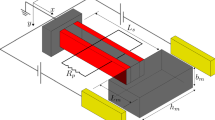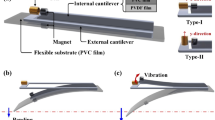Abstract
The characteristics of a new type of electrostatic energy harvesting device, called an out-of-plane overlap harvester, are analyzed for the first time. This device utilizes a movable part that vibrates up and down on the surface of a wafer and a changing overlapping area between the vertical comb fingers. This operational principle enables the minimum capacitance to be close to 0 and significantly increases the energy conversion efficiency per unit volume. The characteristics of the out-of-plane overlap harvester, an in-plane gap-closing harvester, and an in-plane overlap harvester are compared in terms of the length, height, and width of the comb finger and the parasitic capacitance. The efficiency is improved as the length or the height increases and as the width or the parasitic capacitance decreases. In every case, the out-of-plane overlap harvester is able to create more energy and is, thus, preferable over other designs. It is also free from collisions between two electrodes caused by random vibration amplitudes and creates more energy from offaxis perturbations. This device, given its small feature size, is expected to provide more energy to various types of wireless electronics devices and to offer high compatibility with other integrated circuits and ease of embedment.
Similar content being viewed by others
References
S. Roundy, P. K. Wright and J. Rabaey, Comput. Commun. 26, 1131 (2003).
S. P. Beeby, M. J. Tudor and N. M. White, Meas. Sci. Technol. 17, R175 (2006).
S. Roundy, J. Intell. Mater. Syst. Struct. 16, 809 (2005).
R. J. M. Vullers, R. van Schaijk, I. Doms, C. Van Hoof and R. Mertens, Solid-State Electron. 53, 684 (2009).
H. B. Fang, J. Q. Liu, Z. Y. Xu, L. Dong, L. Wang, D. Chen, B. C. Cai and Y. Liu, Microelectron. J. 37, 1280 (2006).
E. K. Reilly and P. K. Wright, J. Micromech. Microeng. 19, 095014 (2009).
R. B. Yates and C. Shearwood, Electron. Lett. 33, 1883 (1997).
A. Harb, Renew. Energ. 36, 2641 (2011).
C. Lee, Y. M. Lim, B. Yang, R.K. Kotlanka, C. H. Heng, J. H. He, M. Tang, J. Xie and H. Feng, Sensor. Actuat. A - Phys. 156, 208 (2009).
L. Mateu and F. Moll, Proc. SPIE Microtechnologies New Millenn. (Sevilla, Spain, May 9-11, 2005), p. 359.
N. S. Hudak and G. G. Amatucci, J. Appl. Phys. 103, 1 (2008).
S. Boisseau, G. Despesse and B. A. Seddik, Small-Scale Energy Harvesting, edited by M. Lallart (InTech, Rijeka, 2012), Chap. 5, p. 105.
B. Hwang, J. Lim and C. K. Kim, Proc. Int. Conf. Manuf. Technol. Eng. (Seoul, Korea, October 18-19, 2012), p. 115.
T. Ha, O. Kwon, J. Kim, J. Oh and T. Won, J. Korean Phys. Soc. 42, S676 (2003).
Author information
Authors and Affiliations
Corresponding author
Rights and permissions
About this article
Cite this article
Kim, CK. Theoretical comparison of the energy conversion efficiencies of electrostatic energy harvesters. Journal of the Korean Physical Society 70, 292–299 (2017). https://doi.org/10.3938/jkps.70.292
Received:
Accepted:
Published:
Issue Date:
DOI: https://doi.org/10.3938/jkps.70.292




